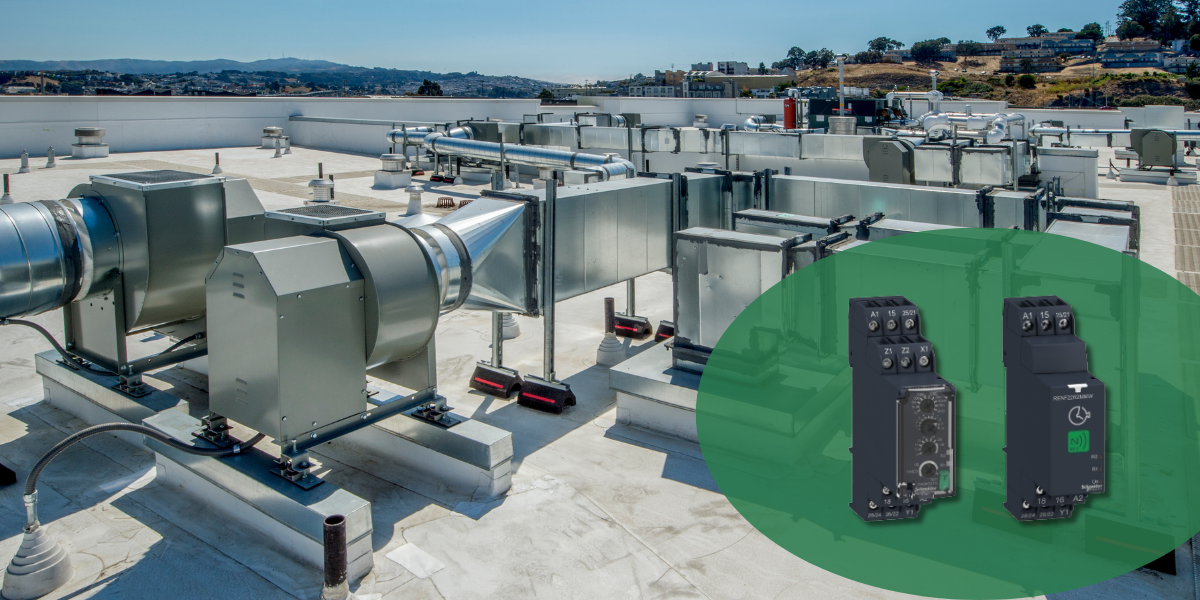Time Relays and Building Automation: A Guide for Installers
Timed relays allow you to optimize the operation of HVAC systems, improving control, automation and energy efficiency.

In the building automation sector, where precision, efficiency, and reliability are the cornerstones of system design, time relays are a key component in ensuring coordinated and optimal system operation. These seemingly simple devices are actually sophisticated time management tools, capable of translating complex control logic into precise and safe operating sequences.
For installers, a thorough understanding of their operation, types, and integration methods into BMS systems is essential today for creating advanced automation systems that comply with regulations and are geared toward energy efficiency.
The role of time relays in automated systems
Time relays are devices that delay the activation or deactivation of an electrical circuit according to a predetermined time interval. Their function is crucial in automated systems, where coordinating operational sequences is essential to ensure efficiency and safety.
The main typologies include:
- On-delay relays (delay on excitation) : they activate the contact after a certain time from the arrival of the control signal.
- Off-delay relays (de-energization delay) : keep the contact active for a defined time after the signal is removed.
- Cyclic relays : generate timed on and off sequences, ideal for periodic processes.
In building automation , these devices integrate with BMS (Building Management Systems) and the most popular communication protocols—such as Modbus, KNX, BACnet, and LonWorks —enabling synchronization with sensors, actuators, and controllers. The main advantages include simplified control logic, reduced consumption, and increased operational reliability of electrical and HVAC systems.
Types of time relays for building automation
In the building automation market, there are three main categories of time relays: electromechanical , electronic and programmable .
- Electromechanical systems are the most traditional solution. They are robust and simple, but offer limited precision and longer response times.
- electronics use solid-state circuits, ensuring high precision, fast response times and a wide adjustment range (from a few milliseconds to several hours).
- Programmable controllers are the most advanced: they integrate microprocessors that allow complex configurations, storage of multiple time profiles and direct communication with PLCs.
For HVAC (Heating, Ventilation and Air Conditioning) applications, the choice of relay must be based on criteria such as time accuracy , supply voltage , compatibility with the control system , and thermal stability . A programmable relay can be the ideal solution for managing comfort and energy saving scenarios on large systems.
Integration with HVAC systems: energy optimization
In HVAC system management, time relays enable optimal sequential control of air conditioning units , fans , and heat pumps . This timing logic prevents simultaneous starts that generate load peaks and allows for efficient distribution of work cycles.
The adoption of programmable timer relays allows for documented energy savings of up to 20-30% , thanks to the intelligent management of on- and off-times based on the building's actual needs. The most effective programming strategies include:
- delayed start of units to reduce power peaks;
- gradual deactivation of the devices at the end of the usage hours;
- synchronization with temperature and presence sensors.
These logics enable dynamic management of the system, in line with the principles of energy management and sustainability.
Practical applications in climate control
Timed relays find application in numerous areas of automated air conditioning :
- Time slot management : schedule switching on and off based on room occupancy.
- Thermal zone control : coordinate multiple independent zones, optimising comfort and consumption.
- Preheating and precooling : activate the systems early to ensure optimal conditions at opening time.
- Peak load management : balance the operation of multiple appliances to avoid electrical overloads.
- Integration with presence or air quality sensors , which automatically activate or deactivate ventilation.
These solutions ensure a comfortable and healthy environment, while reducing energy waste.
Programming and configuration for installers
For installers, programming timed relays requires careful definition of timing parameters (delays, cycles, pulses) and control logic . Integration with PLCs, DDC controllers, or BMSs allows for the implementation of advanced functions such as load priority or adaptive management.
Typical functional schemes involve the use of relays to sequence HVAC units, time restarts after power outages, and manage mode transitions (cooling, heating, ventilation). Common problems include wiring errors, incorrectly set parameters, or incompatible control signals: proper calibration and initial testing are essential to ensure optimal performance.
Regulations and certifications in building automation
The integration of time relays into automation systems must comply with specific European standards . The EN 15232 standard classifies buildings based on the efficiency of their control and automation systems, defining the requirements for achieving classes A and B.
The EPBD (Energy Performance of Buildings Directive) promotes the use of BACS (Building Automation and Control Systems) , which will be mandatory for certain buildings from 2026. The products used must also comply with CE and RoHS certifications and, where applicable, the EN 61812 standards relating to time relays.
Installers can also benefit from incentives and tax deductions , such as the Ecobonus or the Conto Termico , for interventions aimed at improving energy efficiency through the adoption of advanced control systems.
Timed relays, if integrated correctly, represent a strategic solution for any building automation project: simple but essential tools for obtaining intelligent, efficient systems that are fully compliant with European directives on energy and sustainability.




